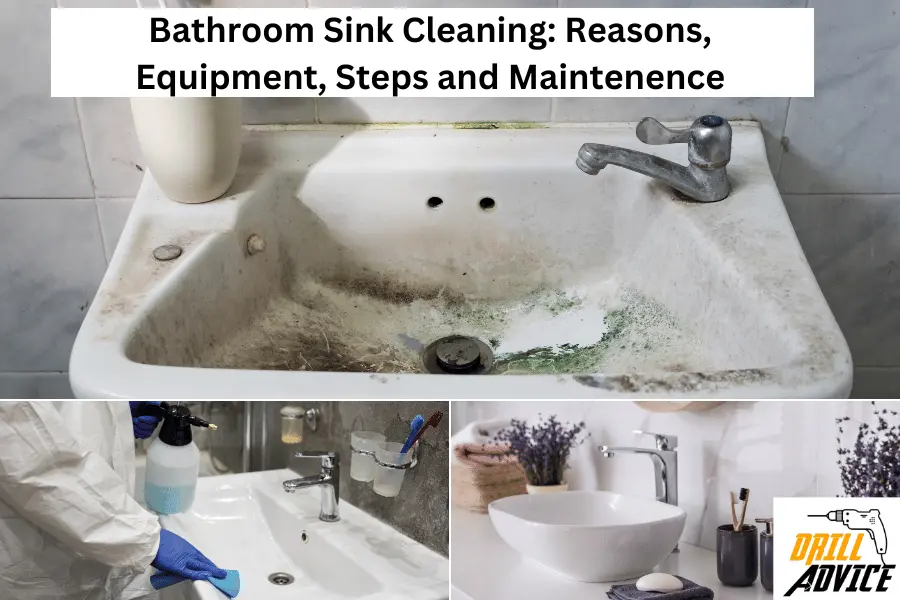
Bathroom sink cleaning is essential for a pleasant and hygienic bathroom. The bathroom sink is the most used fixture in the bathroom. Hence it can dirt and clog easily. The bathroom sink can be dirty due to these 6 reasons.
The bathroom sink can be dirt due to contaminant deposits, toothpaste and creams, soap scum, hair and grooming products, food particles, and makeup residues mainly. You can use bathroom sink cleaners, baking soda and vinegar, a toothbrush, a sponge, rubber gloves, and a face mask to clean the bathroom sink cleaning. Before cleaning the bathroom, you should check for drain clogging. As well as, you should clean the faucet with the sink.
When you clean the bathroom sink, you should not use abrasive powders, acidic cleaners, wire brushes, bleaches for color fixtures, plungers for minor clogs, or boiling water for porcelain for sink. These can damage the sink surface. In order to maintain the bathroom sink properly, you should clean it daily by using mild pH cleaner, keep the drain clean, and check for leaking regularly.
What Can Dirt the Bathroom Sink?
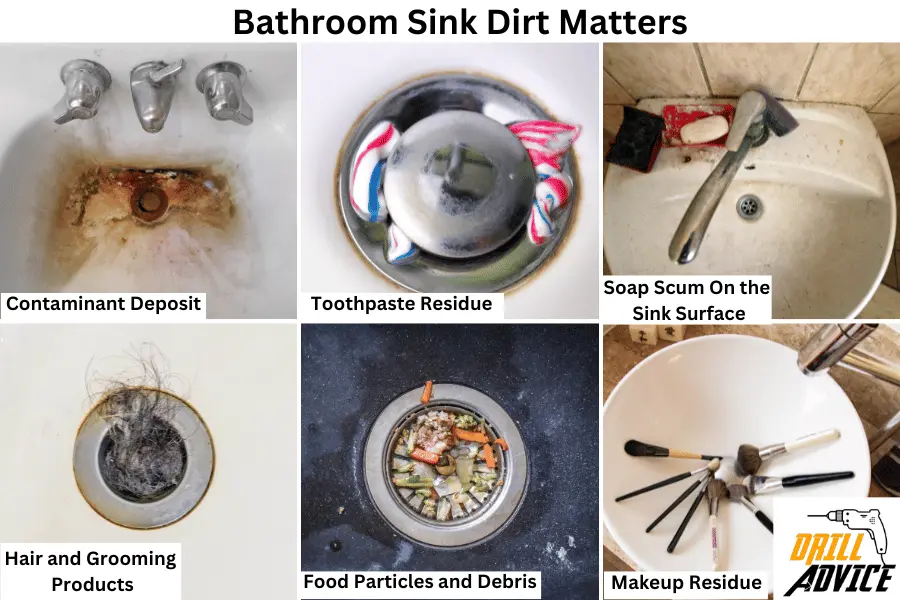
The bathroom sink can be dirty due non dissolved particles in the water. The most problematic dirtiness in the sink are contaminant deposits, toothpaste residues, soap scum, hair and grooming products, food particles, and makeup residues.
- Contaminant Deposit – Tap water includes Calcium and Magnesium ions. These ions can make calcium deposits of the sink surface.
- Toothpaste Residue – When you brush your teeth, toothpaste can be thrown away from the mouth and it can remain on the sink surface, edge, near the faucet easily. When you do not clena the bathroom sink daily, it will dirt due to toothpaste..
- Soap Scum On the Sink Surface – When Soap is mixed with hard water, soap scum occurs. Soap scum is a white stuck layer on the sink surface. It will not be removed easily with the water.
- Hair and Grooming Products – Hair, shaving cream, and other grooming products can cause blockages and even contribute to bacterial growth if not regularly removed from the sink.
- Food Particles and Debris – If you wash your hands or rinse anything in the sink, food particles or other debris can remain on the sink. Because some food particles will not be removed through the sink outlet holes. This will cause clogging of the sink.
- Makeup Residue – Makeup residues can flow on the sink surface when the mirror is used above the sink for makeup purposes. This will cause to make stain marks on the sink.
What You Should Use for Bathroom Sink Cleaning?
You can use a bathroom sink cleaner as well as vinegar and baking soda for the clean the bathroom sink.
- Vinegar and Baking Soda – You can use vinegar and baking soda for cleaning the bathroom sink successfully. You have to mix these in equal parts to create a powerful, natural cleaner. This pase can remove soap scum and mineral deposits successfully.
- Bathroom Sink Cleaners – Bathroom sink cleaners are soft cleaners. Those can be used on porcelain, stainless steel, and glass sinks successfully. These cleaners have a mild pH level and consist of fragrance.
- Toothbrush – An old toothbrush can use for sink cleaning because it can reach the areas and corners where a cloth can’t reach.
- Sponges and Microfiber Cloths – You’ll need these for scrubbing and wiping down the sink.
- Drain Cleaner – For stubborn clogs, consider a chemical drain cleaner or a more eco-friendly enzymatic cleaner.
- Bleach – Use it sparingly and carefully. It’s effective for stain removal and disinfecting but can be harmful if not used properly.
- Rubber Gloves – Don’t forget these to protect your hands, especially if you’re using strong chemicals.
- Face Mask – You shoul use a face mask while you are cleaning the sink. You can protect form the bad smell and harmful fumes from the cleaning liquids.
Read More About
- Bathroom Toilet Cleaning: Reasons, Equipment, Steps and Maintenance
- Bathtub Cleaning: Reasons, Equipment, Steps and Maintenance
- Bathroom Faucet Cleaning: Reasons, Equipment, Steps and Maintenance
How to Clean the Bathroom Sink?
Step 1: Clear the Sink Area
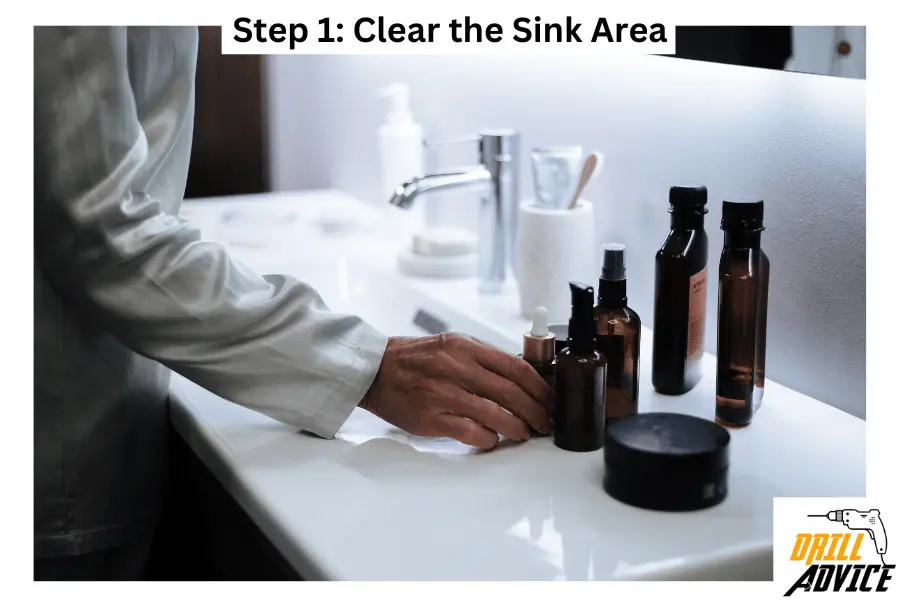
Clear the sink area of any personal items such as toothbrushes, soap, or decorations. This ensures that all surfaces of the sink are accessible for cleaning.
Step 2: Unclog the Sink Drain
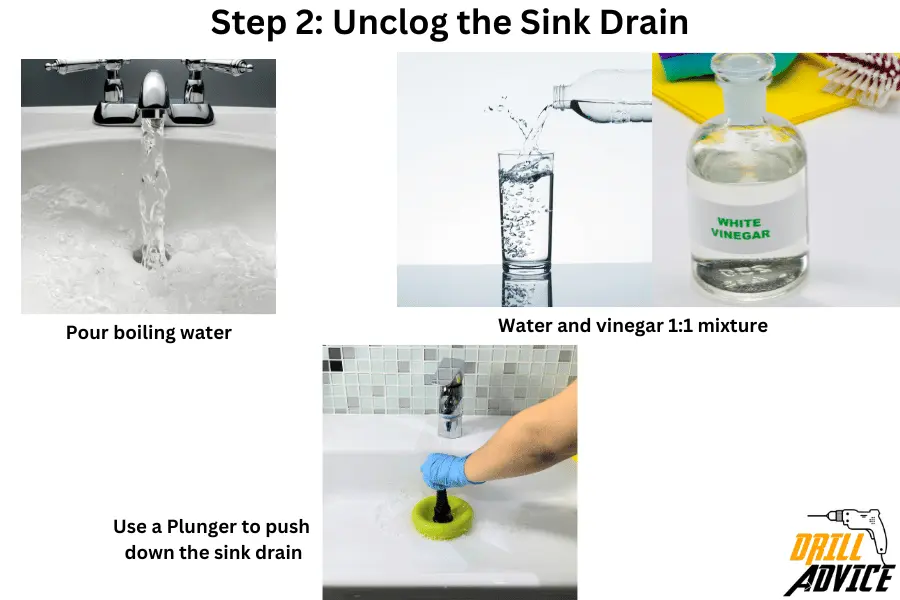
A clogged sink drain will not remove collective water in the sink basin. Hence first sink drain should be unclogged. You can follow the below 3 steps to unclog the sink drain easily.
- Pour boiling water – You can pour boiling water into the sink drain if the drain is clogged. When you pour the boiling water, make sure it is 212 Fahrenheit. If the water exceeds this, PVC and other rubber compounds will be damaged easily.
- Water and vinegar 1:1 mixture – If the sink is still clogged, you can use water and vinegar mixture 1:1. Pour the mixture to the sink and remain 10-15 mins. If the drain is not unclogged easily, you can use a plunger.
- Use a Plunger to push down the kitchen drain – Finally, you can use a plunger to unclog the sink drain.
Step 3: Rinse the Sink with Warm Water
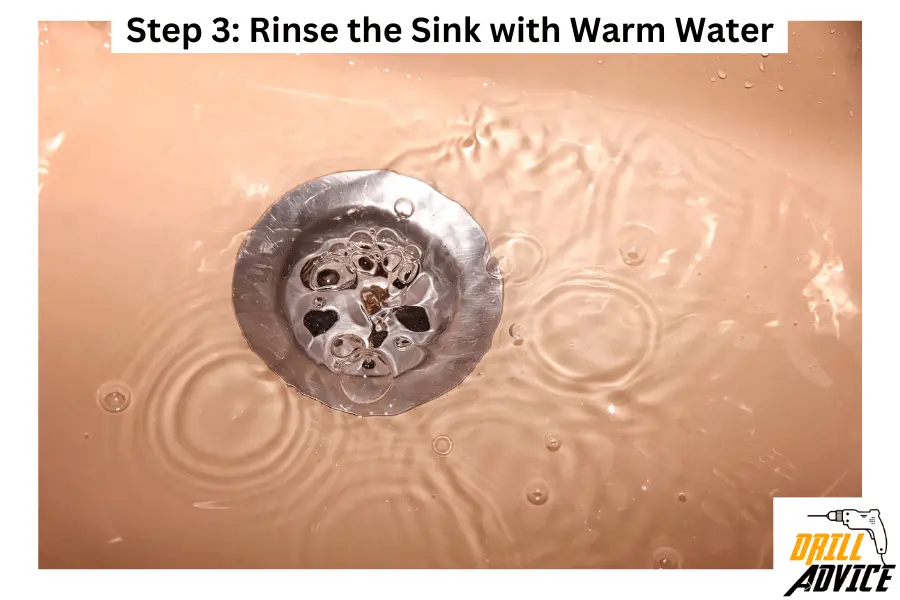
After unclogg the sink drain you can wash the sink surface with warm water. This initial rinse helps loosen up minor grime and makes the cleaning process easier.
Step 4: Apply the Cleaner on the Sink Surface
Based on the type of dirt you’re dealing with, choose an appropriate cleaner. Apply it generously over the sink surface. Let it sit for 3-5 minutes to break down the dirt, but don’t let it dry.
Step 5: Gently Scrub the Sink Surface
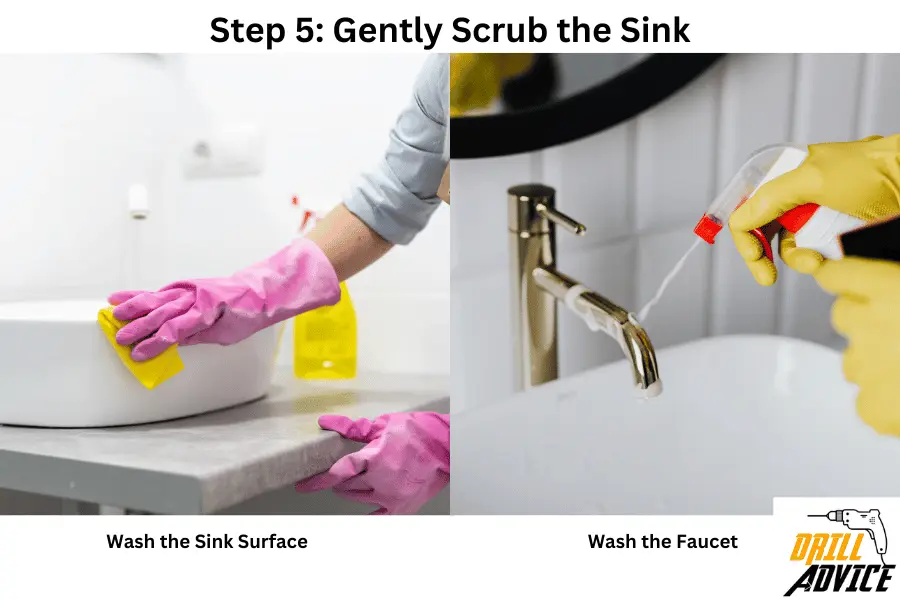
Grab a sponge or scrubbing brush to scrub the sink surface. Use circular motions, focusing on problem areas like stains or soap scum build-up. For corners and around the faucet, use an old toothbrush to reach there.
Wash the Faucet
Use a disinfecting wipe or a cloth dipped in a cleaner to thoroughly clean the faucet, knobs, and spout. Don’t overlook the base and the back of the faucet, where grime tends to collect.
Step 6: Rinse and Remove the Cleaner

You should remove and rinse all the cleaner and grime with warm water. Then, use a microfiber cloth to wipe down the sink to remove any remaining moisture or cleaning solution. This will also give your sink a nice shine.
What You Should Not Use for Bathroom Sink Cleaning?
You should not use these 7 cleaners in the sink. Those are abrasive powders, acidic cleaners, wire brushes, bleaches for color fixtures, plungers for minor clogs, and boiling water for porcelain for the sink. These can scratch the surface, decay due to acids, and crack to the heat. Hence, you should avoid using them for sink cleaning.
- Abrasive Powders – Abrasive cleaners like scouring powders can scratch and damage the surface of your sink, especially if it’s made of porcelain or a softer stone like marble.
- Acidic Cleaners – Acid-based cleaners, including lemon and vinegar, can be harmful to certain surfaces like marble and some metal fixtures.
- Steel Wool or Wire Brushes – These can scratch and damage your sink surface. Once the surface is scratched, it’s more vulnerable to staining and bacteria growth..
- Bleach on Colored Fixtures – If your sink has colored fixtures, using bleach can result in discoloration and fading.
- Mixing Chemicals – Never mix cleaning chemicals like bleach and ammonia, as they can create toxic fumes that are harmful to inhale.
- Plunger for Minor Clogs – For minor clogs, using a plunger can sometimes force the blockage further down the drain, complicating the issue.
- Boiling Water on Porcelain – Dumping boiling water into a porcelain sink can cause it to crack due to the rapid temperature change.
How to Maintain the Bathroom Sink Properly?
You can maintain the bathroom sink by following the 5 steps and methods.
- Daily Quick Wipes – After you brush your teeth or wash your face, take a moment to wipe down the sink. This prevents the buildup of toothpaste, soap scum, and other grime. It’s a lot easier to prevent dirt from setting than to remove it once it’s hardened.
- Weekly Detailed Cleaning – Once a week, give your sink a more detailed clean using the step-by-step method outlined earlier. Focus on problem areas like drains and faucets. Weekly deep-cleans complement your daily wipes, targeting areas that may have been missed.
- Keep the Drain Clear – Regularly remove hair and other debris that might clog the drain. Consider using a drain guard to catch these elements. A clogged drain is not only a nuisance but can also lead to water damage and plumbing costs if left untreated.
- Regularly Check for Leaks – Check the pipes under the sink and the base of the faucet for any signs of leakage. Catching a leak early can save you from higher water bills and potential water damage.
- Use Mild Cleaning Agents – Harsh chemicals and abrasive cleaners can wear down your sink over time, making it more susceptible to staining and scratching. Hence use mild, non-abrasive cleaners for your regular maintenance to preserve the quality and finish of your sink
